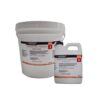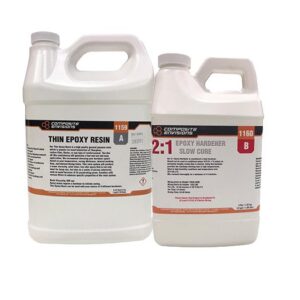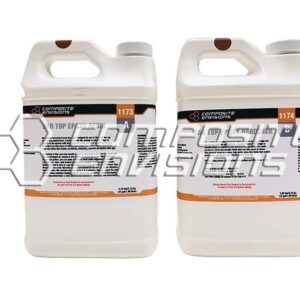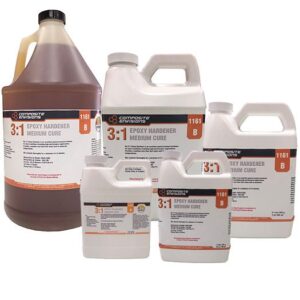Description
Slow Infusion Epoxy is a two-component, very low viscosity system developed specifically for use in resin infusion and VARTM processes. Slow Infusion Epoxy was formulated to provide for rapid saturation of carbon fiber laminate, fiberglass and Kevlar while also allowing for maximum open time. Processability parameters are enhanced due to Slow Infusion Epoxy’s low mixed viscosity and wet-out potential. This system is not designed to be used in open mold applications.
| Handling Properties | ||
| RESIN VISCOSITY, cP | 1,044 | ASTM D 2196 |
| RESIN DENSITY, lb./gal | 9.49 | ASTM D 792 |
| HARDENER VISCOSITY, cP | 38 | ASTM D 2196 |
| HARDENER DENSITY, lb./gal | 7.80 | ASTM D 792 |
| COLOR | Clear | |
| DENSITY, lb./gal | 9.04 | ASTM D 792 |
| MIX RATIO, pbv (pbw) | 3/1 (3.65/1) | |
| MIXED VISCOSITY, cP | 290 | ASTM D 2196 |
| GEL TIME (200g), min | 450 | ASTM D 2471 |
| WORKING TIME*, min | 210 |
*The working time varies according to the temperature of the air, the epoxy and the surface to which it is applied.
Note: Above viscosities/densities measured @ 77°F.
| Physical Properties: | ||
| TENSILE STRENGTH, psi | 10,200 | ASTM D 638 |
| TENSILE MODULUS, psi | 289,000 | ASTM D 638 |
| ELONGATION @ BREAK, % | 4.00 | ASTM D 638 |
| COMPRESSIVE STRENGTH, psi | 13,500 | ASTM D 695 |
| COMPRESSIVE MODULUS, psi | 276,000 | ASTM D 695 |
| FLEXURAL STRENGTH, psi | 17,600 | ASTM D 790 |
| FLEXURAL MODULUS, psi | 1,073,000 | ASTM D 790 |
| HARDNESS, Shore D | 87D | ASTM D 2240 |
Cure Cycle: 24 hours @ Room Temperature + 8 hours @ 180°F. Test specimens for above were neat epoxy (without fiber reinforcement).
The storage temperature of Slow Infusion Epoxy will greatly affect the ease of mixing, application and curing time. For best results, Slow Infusion Epoxy should be stored at (60-80 °F or 16-27 °C) for at least 24 hours before use. Mix RESIN WITH (hardener) for 3 minutes using a Jiffy Mixer and a slow speed drill. Mix at slow speed (less than 500 rpm) to avoid air entrapment. When adding part B to part A, be sure to scrape the sides of the hardener (part B) container in order to remove all of the hardener. This is essential to maintain proper mix ratio. DO NOT mix more material than can be used within the stated working time. REMEMBER – you will have less working time at higher temperatures
SAFETY PRECAUTIONS
Avoid breathing of vapors. Forced local exhaust is recommended to effectively minimize exposure. NIOSH approved, organic vapor respirators and forced exhaust are recommended in confined areas, or when conditions (such as heated polymers, sanding) may cause high vapor concentrations. DO NOT WELD ON, BURN OR TORCH ON OR NEAR, ANY EPOXY MATERIAL. HAZARDOUS VAPOR IS RELEASED WHEN AN EPOXY IS BURNED.







Reviews
There are no reviews yet.